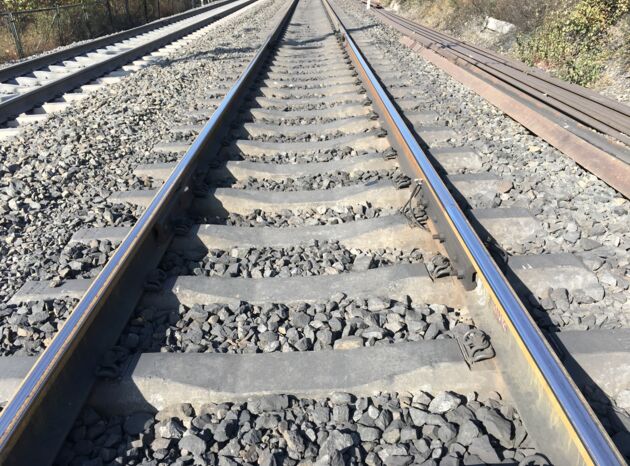Insulated Rail Joints
Stiffness Optimisation of Insulated Rail Joints
Insulated Rail Joints (IRJs) are of high importance for signaling systems in modern railway networks. These systems create a safe and efficient operation by employing the rail as an electrical conduit for train location. To accomplish this, IRJs are used to create blocks or independent sections of track by electrical isolation. Shortened IRJ life often occurs due to different static and dynamic behavior of IRJs compared to the continuous rail. Consequently many problems with track deterioration and signaling malfunction are related to them, which makes IRJs one of the most common problem areas in the track.
Problems
Increased static and dynamic forces due to local stiffness differences lead to ballast deterioration, hanging ties, end post battering as well as metal flow at the rail ends, which can lead to short circuit and subsequently to track closure and increased maintenance requirements.
- Ballast abrasion
- Voids under sleepers
- Signal interferences
- Damages to rails and insulated rail joint components
Solution
In order to optimise the bedding of Insulated Rail Joints, Getzner has developed a tailor made finite element method (FEM) model. By using the IRJ know-how gained in recent years, elastic elements, like Under Sleeper Pads or Rail Pads, can be adjusted precisely to given superstructure conditions. As a result, the track quality is permanently increased. Track measurements in North American heavy haul environment confirm the positive effects of this optimisation.
- Optimized load distribution through the elongation of the bending line of the rail
- Reduction of dynamic forces
- Reduction of ballast contact pressure
- Tamping intervals are extended, significantly reducing maintenance costs
- Extension of insulated rail joints lifetime, therefore fewer signal interferences
- Increase of track availability



Advantages for the customer
- Tailored bedding for Insulated Rail Joints
- Homogenous rail deflection
- Decimated dynamic forces
- Minimised ballast pressure (> 80%)
- Less ballast deterioration
- Reduced maintenance costs
- Less system failures (short circuits, signal errors)
- Extended life span of Insulated Rail Joints
- Economic track operation
Measurements at Insulated Rail Joints
Downloads
Contact
- Afghanistan
- Åland Islands
- Albania
- Algeria
- American Samoa
- Andorra
- Angola
- Anguilla
- Antarctica
- Antigua & Barbuda
- Argentina
- Armenia
- Aruba
- Australia
- Austria
- Azerbaijan
- Bahamas
- Bahrain
- Bangladesh
- Barbados
- Belarus
- Belgium
- Belize
- Benin
- Bermuda
- Bhutan
- Bolivia
- Bosnia & Herzegovina
- Botswana
- Bouvet Island
- Brazil
- British Indian Ocean Territory
- British Virgin Islands
- Brunei
- Bulgaria
- Burkina Faso
- Burundi
- Cambodia
- Cameroon
- Canada
- Cape Verde
- Caribbean Netherlands
- Cayman Islands
- Central African Republic
- Chad
- Chile
- China
- Christmas Island
- Cocos (Keeling) Islands
- Colombia
- Comoros
- Congo - Brazzaville
- Congo - Kinshasa
- Cook Islands
- Costa Rica
- Côte d’Ivoire
- Croatia
- Cuba
- Curaçao
- Cyprus
- Czechia
- Denmark
- Djibouti
- Dominica
- Dominican Republic
- Ecuador
- Egypt
- El Salvador
- Equatorial Guinea
- Eritrea
- Estonia
- Eswatini
- Ethiopia
- Falkland Islands
- Faroe Islands
- Fiji
- Finland
- France
- French Guiana
- French Polynesia
- French Southern Territories
- Gabon
- Gambia
- Georgia
- Germany
- Ghana
- Gibraltar
- Greece
- Greenland
- Grenada
- Guadeloupe
- Guam
- Guatemala
- Guernsey
- Guinea
- Guinea-Bissau
- Guyana
- Haiti
- Heard & McDonald Islands
- Honduras
- Hong Kong SAR China
- Hungary
- Iceland
- India
- Indonesia
- Iran
- Iraq
- Ireland
- Isle of Man
- Israel
- Italy
- Jamaica
- Japan
- Jersey
- Jordan
- Kazakhstan
- Kenya
- Kiribati
- Kuwait
- Kyrgyzstan
- Laos
- Latvia
- Lebanon
- Lesotho
- Liberia
- Libya
- Liechtenstein
- Lithuania
- Luxembourg
- Macao SAR China
- Madagascar
- Malawi
- Malaysia
- Maldives
- Mali
- Malta
- Marshall Islands
- Martinique
- Mauritania
- Mauritius
- Mayotte
- Mexico
- Micronesia
- Moldova
- Monaco
- Mongolia
- Montenegro
- Montserrat
- Morocco
- Mozambique
- Myanmar (Burma)
- Namibia
- Nauru
- Nepal
- Netherlands
- New Caledonia
- New Zealand
- Nicaragua
- Niger
- Nigeria
- Niue
- Norfolk Island
- North Korea
- North Macedonia
- Northern Mariana Islands
- Norway
- Oman
- Pakistan
- Palau
- Palestinian Territories
- Panama
- Papua New Guinea
- Paraguay
- Peru
- Philippines
- Pitcairn Islands
- Poland
- Portugal
- Puerto Rico
- Qatar
- Réunion
- Romania
- Russia
- Rwanda
- Samoa
- San Marino
- São Tomé & Príncipe
- Saudi Arabia
- Senegal
- Serbia
- Seychelles
- Sierra Leone
- Singapore
- Sint Maarten
- Slovakia
- Slovenia
- Solomon Islands
- Somalia
- South Africa
- South Georgia & South Sandwich Islands
- South Korea
- South Sudan
- Spain
- Sri Lanka
- St. Barthélemy
- St. Helena
- St. Kitts & Nevis
- St. Lucia
- St. Martin
- St. Pierre & Miquelon
- St. Vincent & Grenadines
- Sudan
- Suriname
- Svalbard & Jan Mayen
- Sweden
- Switzerland
- Syria
- Taiwan
- Tajikistan
- Tanzania
- Thailand
- Timor-Leste
- Togo
- Tokelau
- Tonga
- Trinidad & Tobago
- Tunisia
- Türkiye
- Turkmenistan
- Turks & Caicos Islands
- Tuvalu
- U.S. Outlying Islands
- U.S. Virgin Islands
- Uganda
- Ukraine
- United Arab Emirates
- United Kingdom
- United States
- Uruguay
- Uzbekistan
- Vanuatu
- Vatican City
- Venezuela
- Vietnam
- Wallis & Futuna
- Western Sahara
- Yemen
- Zambia
- Zimbabwe

Mychal Weidman
Railway Sales Manager USA and Canada



